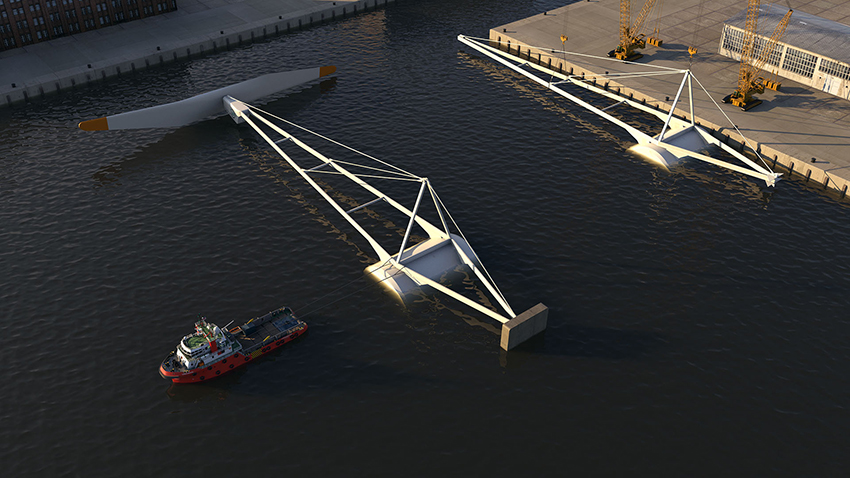|

13 September 2023
By
Michelle Lewis
Single-blade wind turbine works at
wind speeds of 157 mph
The design takes out expensive components
of the three-blade turbine while also offering lower costs for
installation and servicing.

Artist's illustration of the single blade turbine
at work
Netherlands-based TouchWind BV isn't a regular
player in the wind energy industry, looking to make larger wind
turbines to harness more energy. Instead, the company is working to
change what a wind turbine looks like, dumping the three blades in
favor of a single large one.
For years, the wind energy industry has adopted the three-blade model
for its turbines. As the world looks for cleaner sources of energy,
the turbines are getting larger and are also going deeper into the
seas, where winds blow stronger.
The turbine design requires adaptions in these environments, such as
pitch control, to generate maximum power. These additions add to the
cost of the turbine, but when wind speeds exceed design
specifications, the turbine needs to be shut down to avoid damage.
Touchwind's single-blade design solves both these issues in one
stroke.
How does a single-blade turbine work?
The blade is attached to the mast at a slight upward angle. When the
wind speed is low, the mast tilts over and falls into the water but is
prevented from doing so by a dangling buoy.
As the wind speed increases, the spin motion of the single blade
generates lift and pulls the mast upright. The buoy is lifted out of
the water and now serves as a ballast weight to keep the blade from
taking off. Since the blade is no longer at an angle to the wind, it
prevents it from spinning faster. The whole assembly is floating on
the water's surface and anchored to the sea floor.
TouchWind claims that its turbine can function at wind speeds of up to
70 meters per second (157 mph), with the rotor finding its own pitch.
In comparison, a conventional three-blade turbine has to be stopped at
wind speeds exceeding 25 meters per second (56 mph).
The cost reduction
Since the design does not need pitch control systems, which are
expensive components, TouchWind claims that costs of manufacture can
be reduced by as much as 30 percent. The lack of multiple components
also makes it feasible to manufacture the turbine at the harbor,
further reducing the costs of transport.

Fully assembled single blade turbine can be towed
to site of installation - TouchWind
The assembled turbine can simply be towed from
the harbor to the site of installation and become functional after
being anchored to the sea floor. A 656-foot (200 m) blade is estimated
to generate 12 MW of electricity, sufficient to power 15,000
households.
As turbines get larger and farther into the sea, maintaining them is
becoming a herculean task. Weather conditions can get quite rough in
the deep sea, and taller turbines need access via a crane or
helicopter to complete routine maintenance.
In TouchWind's design, the maintenance crew only needs to grab the
cable connecting the buoy and rotor. With the rotor not spinning, the
assembly lies closer to the water surface and can be serviced using a
boat.
The company is currently carrying out field tests of its small-scale
designs in the Netherlands and even received investments from a
Japanese shipping Mitsui OSK Lines. The shipping company also invested
in another wind turbine company, SeaWind, last year.
Details of the commercial rollout of the technology are not available
yet.
Green Play Ammonia™, Yielder® NFuel Energy.
Spokane, Washington. 99212
509 995 1879
Cell, Pacific Time Zone.
General office:
509-254
6854
4501 East Trent
Ave.
Spokane, WA 99212
|